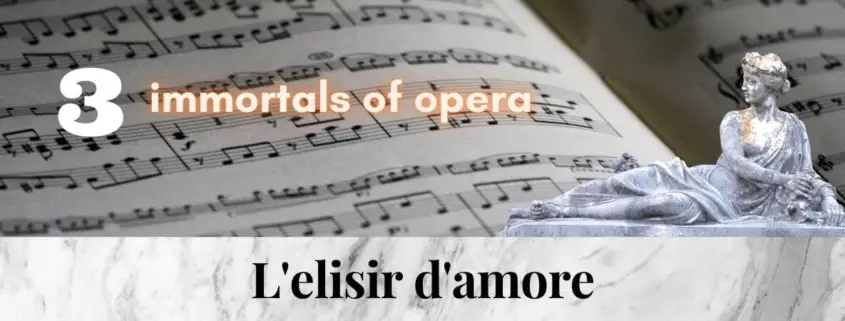L’elisir d’amore is among the absolute greatest that Italian “opera buffa” produced in the 19th century. With Adina, Nemorino, Dulcamara and Belcore, Donizetti created no less than four great characters who are among the most sought-after roles of their subjects. Donizetti’s richness of melody is extraordinary and the triumphant premiere became one of the most joyous moments of his musical career.
Pavarotti the unbeatable Nemorino
In this cavatina (a songlike aria) Donizetti draws a simple, thoughtful man in love. In plain C major, Nemorino sings of his longing for Adina’s love. Only at “Essa legge, studia…” do we hear a minor-key haziness, implying that Adina’s education may make her unattainable to Nemorino.
We hear Luciano Pavarotti in this recording. The role of Nemorino was one of his absolute parade roles. In this role he celebrated real triumphs in many opera houses. The vocal subject requires a lyric tenor and the role a simple, but mischievous rascal, which was just perfect for Luciano Pavarotti.
Quanto è bella, quanto è cara – Pavarotti
Nemorino drinks the love potion
Now Nemorino also possesses a weapon, he is equipped with the wine and the psychological feud with Adina takes its course. Adina has noticed that something has changed in Nemorino. Encouraged by the wine, Nemorino ventures a melody of his own (“Esulti pur la barbara”), and this time it is Adina who dutifully repeats it. He even challenges her twice with coloratura, which she resolutely answers twice with clear top notes. Now the duet ends with a unison of voices, a sign that Nemorino’s standing with Adina has increased.
See this excerpt in a 2005 recording with a delightfully comedic Rolando Villazón and Anna Netrebko.
Caro Elisir…Esulti pur la barbara – Villazón / Netrebko
Donizetti’s famous aria “Una furtiva lagrima”
Introduced by a bassoon solo and harp (an interesting combination!), this famous aria begins. Besides the beauty of its motifs, it captivates the peculiarity that the first part of each verse is in minor and the second in major. This transition from pain to hope is wonderfully enhanced by the expressive instrumentation with bassoon and clarinet.
In 1901, Enrico Caruso sang this aria for the first time. It was his debut season at La Scala and Toscanini conducted. What followed was the greatest ovation yet heard in that theater. It went on to become one of the most important operas of his career at the Met. “Una furtiva lagrima” was among the first arias Caruso recorded and (along with “Vesti la giubba”) became his trademark. In this recording, backed by a modern orchestra, the classical rubato can be heard. Listen, for example, to the second “Che più cercando io vo” which, combined with a grandiose accelerando, is twice as long as Pavarotti’s 80 years later. The same can be said of the (wonderfully) long ritardando on “Io la vedo.” In the second part of the aria, Nemorino imagines holding Adina in his arms and feeling her heartbeat. Listen to Enrico Caruso as he tenderly sings this passage and then exults with one the “Cielo”. The final crescendo on “Si può morir” delights with the full swelling of the sound and the glowing final notes.
What is the reason for this discrepancy between Caruso’s and Pavarotti’s interpretations? In the 20th century the hour of the tyrant Toscanini struck, who, under the title of fidelity to the work, drove out the rubato from the singers and thus led the interpretation into new directions until today.
Una furtiva lagrima – Caruso







Leave a Reply
Want to join the discussion?Feel free to contribute!